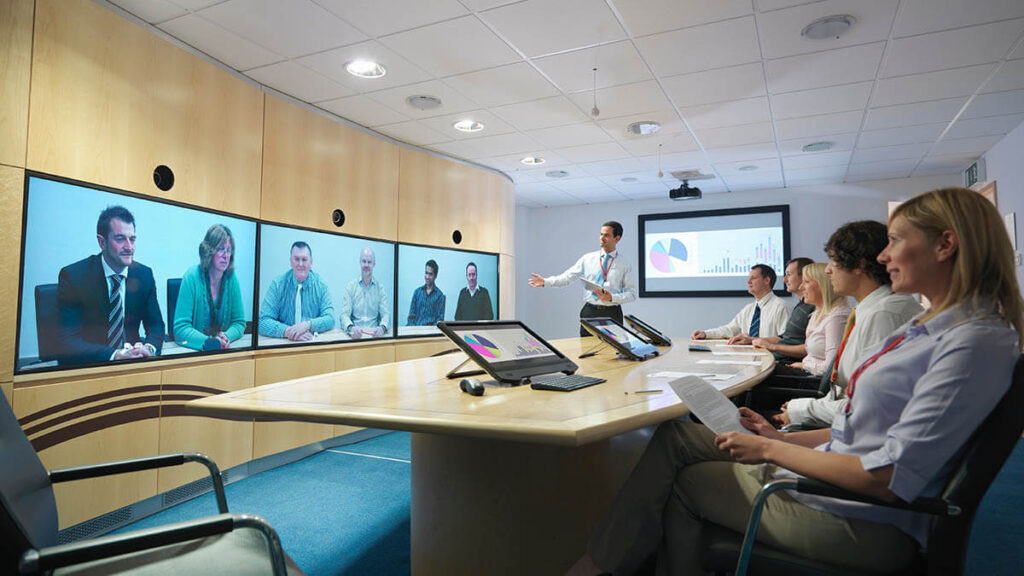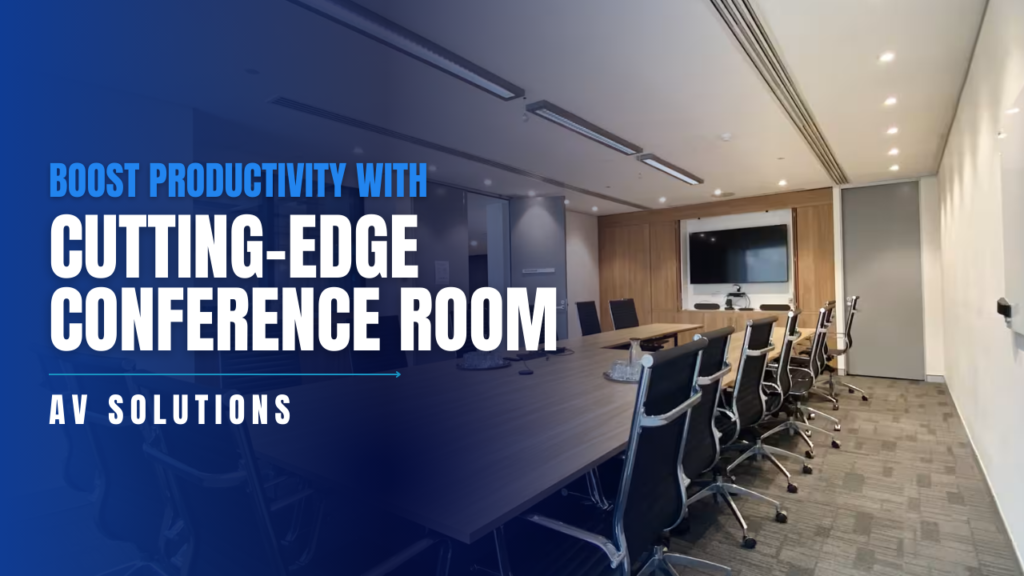Boost Productivity with Cutting-Edge Conference Room AV Solutions
Table of Contents
Do technical glitches, poor audio quality, and outdated equipment constantly disrupt your meetings? Does the thought of connecting devices or troubleshooting your AV system frustrate you? These are common challenges for businesses, especially large organizations, where every minute lost can directly impact productivity. The modern conference room is more than just a meeting space—it’s the center of collaboration, decision-making, and innovation.
With the shift towards hybrid work models, conference rooms must accommodate in-person and remote attendees. However, many traditional AV systems can’t handle this growing demand for seamless communication and interaction. This is where cutting-edge AV solutions come into play. Companies can create intuitive, efficient, and productivity-boosting spaces by adopting these advanced technologies.
In this blog, we’ll explore how advanced AV systems solve the common pain points businesses face today, offering a technical deep dive into how they can enhance productivity in the workplace.
1. The Modern Conference Room – A Hub for Critical Business Operations
Conference rooms have evolved from simple spaces for in-house meetings to critical hubs for global collaboration. These rooms are where key decisions are made, clients are pitched, and teams come together to brainstorm innovative solutions. However, traditional AV setups often fall short of supporting this type of dynamic collaboration.
Imagine this scenario: a CEO is about to give a high-stakes presentation to stakeholders in different parts of the world. The video won’t connect, and the audio keeps cutting out. Time is wasted trying to fix these technical issues, leading to frustration and lost opportunities.
According to a survey by Poly, 89% of companies report that ineffective video conferencing negatively impacts their business. With such high stakes, conference rooms must be equipped with the right technology. Let’s examine how cutting-edge AV solutions can address these problems.
2. Pain Points in Traditional AV Solutions
Businesses commonly face the following challenges in traditional AV setups:
Inconsistent Connectivity
One of the most frequent problems in conference rooms is inconsistent device connectivity. Traditional systems often require multiple cables and adapters, leading to compatibility issues. For instance, someone with a MacBook may struggle to connect to a system designed primarily for Windows. This problem can slow down meetings and cause unnecessary delays.
Modern AV solutions, however, provide wireless connectivity that eliminates the need for physical connections. BYOD (Bring Your Device) technologies allow employees to wirelessly connect their laptops, smartphones, or tablets to the system. Wireless presentation systems like Barco ClickShare or Crestron AirMedia enable seamless collaboration, ensuring that meetings start on time and run smoothly.
Poor Audio/Video Quality
Have you ever attended a meeting where the video was grainy or the sound kept cutting out? Poor-quality audio and video can significantly reduce the effectiveness of a meeting. Traditional setups often use low-resolution displays and outdated speakers, making it difficult for participants—especially remote attendees—to stay engaged.
Cutting-edge AV solutions offer 4K and 8K ultra-high-definition displays that deliver crystal-clear images. With these displays, participants can see everything clearly, whether it’s a detailed graph or a speaker’s facial expressions. Similarly, high-definition audio systems like Dante ensure that every word is heard clearly, reducing misunderstandings and improving communication.
Time Wasted on Setup
In a fast-paced business environment, time is of the essence. Traditional AV systems often require complex setups that can take 10-15 minutes to start. This time adds up, especially in large organizations where meeting rooms are in constant use.
Modern AV systems simplify the setup through intuitive touch panel controls. Solutions like Crestron and Extron offer centralized control systems that allow users to manage everything from lighting to sound with just a few taps. These systems eliminate the need for multiple remotes or technical expertise, ensuring that meetings start on time and without unnecessary delays.
Limited Integration with Collaboration Tools
With more companies adopting hybrid work models, integrating with Unified Communication (UC) platforms is crucial. However, traditional AV systems often struggle to seamlessly integrate with popular tools like Zoom, Microsoft Teams, or Google Meet, leading to disruptions in virtual meetings.
Cutting-edge AV solutions are designed with these tools in mind. Systems like Cisco Webex and Polycom offer native integration with UC platforms, making it easy for users to launch meetings, share content, and collaborate in real time without switching between applications.
Scalability Issues
In large organizations, conference rooms come in all shapes and sizes—from small huddle spaces to large boardrooms. Traditional AV systems are often designed for a specific room size, making it difficult to scale across different locations.
Modern AV solutions provide scalable systems that can adapt to different room configurations. For instance, Crestron Flex and Zoom Rooms offer flexible setups that work in any space, ensuring a consistent experience no matter where you are.
3. Cutting-Edge AV Solutions Addressing Key Challenges
The latest AV technology advancements solve the pain points of traditional setups and enhance productivity. These solutions are built to simplify the meeting experience, making it more user-friendly, efficient, and seamless.
Wireless Connectivity and BYOD Support
In traditional setups, cables are a constant source of frustration. Modern AV systems eliminate this hassle by enabling wireless connectivity. With BYOD support, users can easily share their screens from any device, whether a laptop, tablet, or smartphone, without needing an adapter. Technologies like ClickShare and AirMedia make wireless presentations as simple as pressing a button.
4K/8K Ultra HD Displays & High-Definition Audio
High-resolution displays are critical for keeping participants engaged, especially in meetings involving detailed content like charts or videos. 4K and 8K displays provide an immersive experience where every detail is precisely visible. HDMI 2.1 technology supports these ultra-high-definition resolutions, ensuring a smooth, lag-free display. Similarly, high-definition audio systems enhance voice clarity, ensuring everyone can hear and contribute effectively.
Intuitive Touch Panel Controls
Simplified control systems are essential for user-friendly meetings. With touch panel controls, like those offered by Crestron and AMX, users can manage the entire room environment—from audio levels to display settings—through a single interface. These controls can be programmed to adjust the room’s configuration based on the number of attendees, providing flexibility for different meeting formats.
Unified Communication Platforms
The ability to seamlessly integrate with UC platforms is crucial for hybrid meetings. Solutions like Zoom and Microsoft Teams Rooms are designed with native integrations, ensuring users can start meetings without delays. These systems automatically adjust audio and video settings for remote participants, ensuring that virtual attendees feel as included as those in the room.
Scalable Systems
A scalable AV system can be adjusted to fit any room size, whether a small huddle room or a large conference hall. AV-over-IP (Audio-Visual over Internet Protocol) technology allows for the distribution of audio and video signals over a network, making it easy to extend AV capabilities to multiple rooms without the need for separate setups.

4. Leveraging AI and Automation for Maximum Productivity
The future of AV technology is not just about better displays and sound. It’s also about AI and automation. These technologies transform conference rooms into intelligent spaces that adapt to users’ needs.
AI-Powered Smart Cameras
AI-powered cameras are one of the most significant advancements in modern AV systems. These smart cameras, such as those from Huddly IQ or Poly Studio, use artificial intelligence to automatically track active speakers and adjust the camera angle. This ensures the speaker is always focused, even in large rooms with multiple participants. Additionally, these cameras can zoom in on individuals or groups, providing a more personalized experience for remote attendees.
Room Scheduling and Analytics Tools
Efficient room management is key to maximizing productivity. With room scheduling tools, users can book conference rooms through integrated calendar systems like Outlook or Google Calendar. These tools can also provide analytics on room usage, helping businesses identify which rooms are underutilized and optimize space accordingly.
Voice-Activated Controls
Voice-activated controls are becoming increasingly popular in AV systems. Technologies like Amazon Alexa for Business or Google Assistant allow users to control the room environment—such as starting a meeting or adjusting the lights—using simple voice commands. This hands-free functionality enhances productivity by reducing the time spent on manual control tasks.
5. The Impact of AV on Productivity and Collaboration
The adoption of cutting-edge AV solutions has a direct impact on business productivity and collaboration.
Faster Meeting Start Times
According to a report by Logitech, modern AV systems can reduce meeting start times by 15%, allowing teams to dive into discussions without technical delays. This time-saving translates into greater overall productivity.
Improved Decision-Making
Clear audio and video allow participants to engage fully in discussions, resulting in faster, more informed decision-making. High-quality AV systems allow teams to review data, share insights, and collaborate in real-time, leading to quicker consensus.
Enhanced Collaboration
Collaboration becomes easier when remote and in-person participants can interact seamlessly. High-quality audio and video and real-time content sharing ensure everyone is on the same page, regardless of location.
6. Future-Proofing the Conference Room AV Solutions for Tomorrow
As businesses continue to evolve, so do their conference room needs. Future-proofing your AV solutions ensures that your organization is ready for new challenges.
Adapting to Changing Work Styles
Hybrid and remote work models are here to stay. Modular AV solutions allow businesses to upgrade their systems as technology evolves, ensuring that their conference rooms remain relevant and equipped to handle the needs of tomorrow.
Sustainability Considerations
In addition to boosting productivity, modern AV systems are designed with energy efficiency in mind. Automated power management systems can help reduce energy consumption by turning off equipment when not in use, contributing to corporate sustainability goals.
Conclusion
Cutting-edge conference room AV solutions are no longer optional—they boost productivity and foster seamless collaboration in today’s corporate environment. With wireless connectivity, 4K/8K displays, AI-powered automation, and intuitive control systems, these solutions address the most common pain points and transform outdated meeting rooms into high-tech collaboration hubs.
If you’re ready to upgrade your conference room and boost your team’s efficiency, contact Theurgy AV Solutions today. Let us help you create a conference room built for the future.

